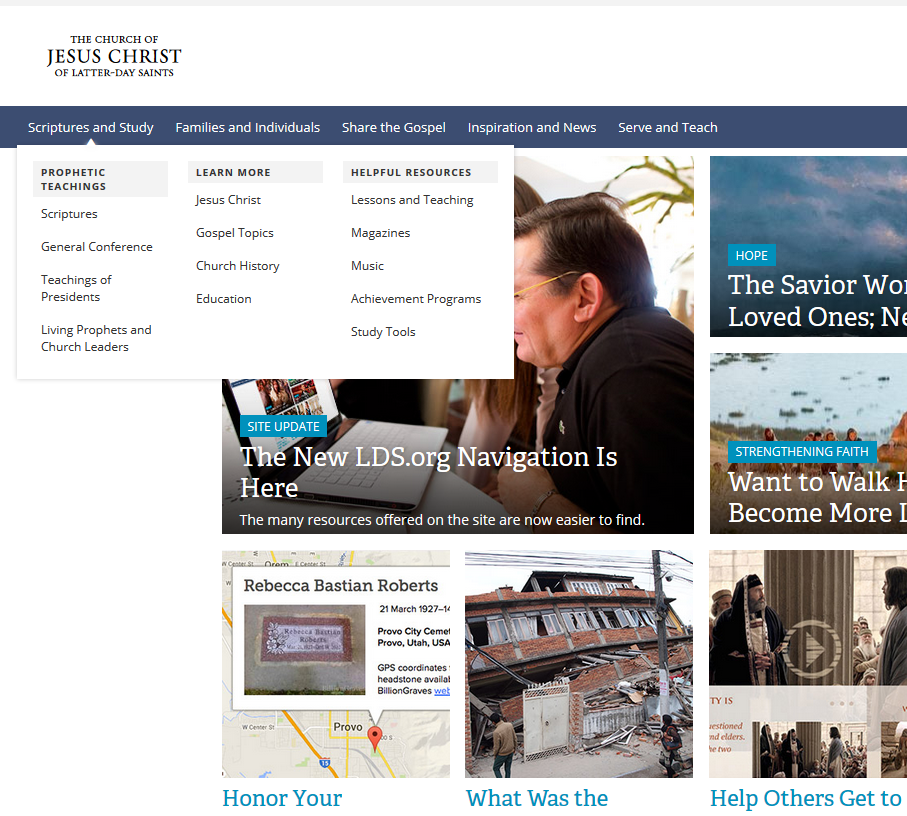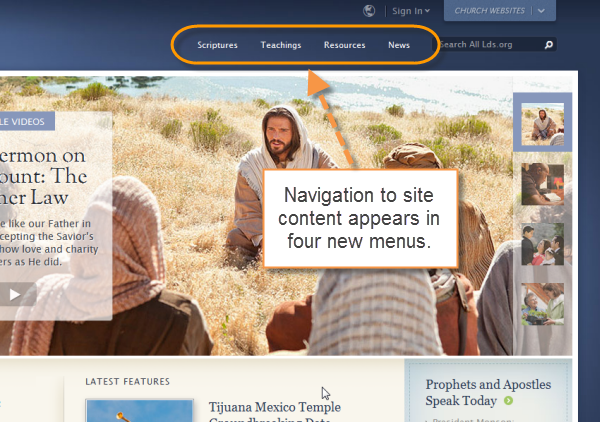Last week, the Church rolled out a redesigned version of the navigation menus at lds.org. The new menus rearranged links to parts of the site in order to make it easier for site visitors to find what we’re looking for.
One change in particular that seems unrelated to usability caught my eye, though. In the old menus, scriptures appeared in their own menu, and General Conference was in a menu labeled “Teachings.” Here’s a screenshot that shows the old menus. I’m sorry it doesn’t show General Conference under “Teachings,” as the old menus aren’t available anymore so I can’t take a new screenshot. I’ll just have to ask you to trust me that it was there. Also note that the callout calls the menus “new” because this image is from 2012, when the old menus were introduced.
In the new menus, by contrast, scriptures and General Conference are put together in the same menu, which is labeled “Prophetic Teachings”:
 I know this might seem like a small thing, but I had always assumed that the old layout was deliberate in not making Conference equal to scriptures. This is why I found the new layout so striking.
I know this might seem like a small thing, but I had always assumed that the old layout was deliberate in not making Conference equal to scriptures. This is why I found the new layout so striking.
Considering the question more, I probably shouldn’t have been surprised. If anything, we probably hold Conference in higher esteem than the scriptures. There’s the commonly-made statement that the most recent Conference Ensign should be considered equal to the scriptures. But even more importantly, we have space in our tradition to notice errors in the scriptures, but we really don’t have space to notice errors in Conference, at least not in recent Conferences. For the scriptures, we have the Eighth Article of Faith that tells us the Bible might not be perfect, and the Book of Mormon admits to the possibility of faults on its title page, and Joseph Smith famously described it not as a perfect book, but only as the “most correct book.” On the Conference side, there’s Elder Ballard telling us “We will not and … cannot lead [you] astray,” [ellipses and brackets in original] and Wilford Woodruff’s statement that we have with OD1: “The Lord will never permit me or any other man who stands as President of this Church to lead you astray.”
In the end, I guess, we ignore lots of our scriptures. We don’t need explicit guidance to ignore them; we just emphasize the parts that match what we’re doing now. The same is also true of old Conferences. If Bruce R. McConkie or Joseph F. Smith or Brigham Young (especially!) said something weird or out of line with our current practice, we just ignore it. It’s really the recent Conferences that trump everything else, because everything else in the past can be reinterpreted or ignored as needed. You might laugh at me and say that this is a blinding flash of the obvious, and that of course current revelation trumps older revelation, but I guess I’m just saying I’m a little surprised at how unmoored I feel like we are. It feels kind of like scriptures and older teachings serve no purpose other than as proof texts so that we can argue that there’s precedent for whatever we’re doing now, whatever it might be.
Anyway, to get back to the lds.org menus, I guess I should expect that at some point in the future, they’ll be redesigned again to put General Conference ahead of scriptures. I think that would match better with how we treat them.

I can’t help wondering if this is a dig at me, and the conversation I was having at BCC yesterday.
I don’t quite share your concern about Conference talks superseding scripture for two reasons:
First, we — in this generation — *do* have space for noticing errors in Conference. It’s called the Internet. Haven’t you noticed how immediately and eagerly and permanently certain elements decide within minutes after a Conference talk just what is an error? These supposed errors are compiled and catalogued and endlessly circulated, so that when I ask for any Conference talk in the past 100 years that preaches against the “evils of interracial marriage,” no one is able to come up with one — but they can come up with lists of skeevy statements made at other times or in trivial places that have been compiled and catalogued and endlessly circulated. When someone *cough*BoydKPacker*cough* says something that isn’t loved by the makers of those lists, his comments go into the catalogue, to be trotted out when wanted. If that isn’t a “space for noticing errors,” “errors” being defined according to the criteria of the listmakers, I don’t know what is.
And second, I cannot agree to your claim that scripture/old material is treated as nothing more than prooftext precedent for “what we are doing now.” You know, I think, that I’m one of the ‘nacle cheerleaders for actual study of scripture and history, in context, not as prooftext. That’s at the base of all my posted Sunday School lessons, and connecting past and present is the heart — “heart” standing here for “emotional center” — of what I do at Keepa. The past resonates with us, I write, because of what is constant between “then” and “now.”
BUT. But the scriptures would be of little value to us if we insisted on nothing but “original intent.” When I taught Old Testament prophecy last year, I did try to guide my class to understand what, for instance, Isaiah’s prophecies meant to the Israelites of his day. Those Israelites would have found very little use, or comfort or warning or any other value, in his prophecies had they all been understood then to apply to a distant day, like the gathering of Israel in our dispensation. On the other hand, those prophecies would be of very little value or interest to us today if we read them only as having to do with Assyrian captivity, exile, and return. Scriptures simply have to be reimagined by prophets to speak appropriately to each passing generation, or they have no value beyond that of any other ancient artifact of a dead civilization.
That’s how I see Conference talks. Prophetic leaders — some more successfully than others — draw on the scripture of the past and apply it to today’s conditions. These speakers bring the past into the present, they correct the errors of the past (!), and they speak and warn of the present and near-term future. That’s why “provident living” means something today other than building an ark; why “gathering” means building congregations and temples everywhere and not a physical traveling to Mecca or Salt Lake City; and why we support clean water initiatives, vaccinations, and the Perpetual Education Fund instead of relying on ancient dietary codes to protect us from disease and ancient inheritance laws to decide our children’s occupations.
Not all Conference discourse is created equal — just as I doubt the Bible gives us every prophetic word of Samuel or Elijah or Obediah, not every word of General Conference survives as important from year to year. Gems stand out, the trivial and the mistaken drops out — as far as the eager internet compilers will allow it to drop out. As much as anything, it’s the pattern of repetition (or dropping) of ideas in current Conference discourse that helps us understand how ancient scripture should guide us today, and and when and how to let go of some “weird thing” Brigham Young said.
So you got a blog post instead of a comment. I’ll leave it here, or transfer it, as you wish.
Scripture and General Conference addresses, while at their core are centered around their interpretation of God’s will and desired teachings, are very different in a lot of ways.
I think the their is a general desire to merge the two for simplicity’s sake, but that introduces the conflation problem the OP has alluded to.
There are similarities such as the author’s belief that what they are writing and saying is of God and that there is value to be had for others.
There are differences in that the scriptures have passed the tests of time and have been accepted as spiritually fruitful by a large consensus of believers. General conference addressees have not received that consensus and many of the talks and addresses are forgotten or even repudiated years later.
Recognizing these differences I believe our treatment or reaction to both should be to seek to understand the author’s intent, to process the message with our experience and understanding, and seek spiritual growth based on our conclusions. In other words we should be chewing on the words of spiritual leaders past and present. Ultimately you will accept or reject the individual ideas communicated, regardless you will grow because you will understand who you are better and hopefully who God is.
Sorry, Ardis. Not a dig at you at all. I don’t think I’ve even read the discussion you’re referring to yet. I was really more thinking out loud than anything else with this post, so thanks for your comment and providing more thought on the question.
And thanks for your comment, Matt.
When the day comes that conference speakers have to laboriously engrave words on metal plates meant to survive thousands of years and to redeem a people–and they both explicitly acknowledge that the Lord personally visited with them (as so many of the Book of Mormon prophets do) and forsake the possibility of video editing by the kind folks in the church office building–then I’ll be more than happy to accord them the same status as scripture :-).
A further thought: the scriptures that we have are “best of” compilations. Editors culled out the stuff most worth keeping. The proper analogy between scriptures and general conference would be a compilation of phenomenol general conference talks that everyone agreed were authoritative and expressed true doctrine. We should eagerly await such a compilation, which the Ensign is not.
There is a picture halfway down the page that show general conference listed under “scriptures” in the gospel library app.
http://www.nearingkolob.com/solution-selling-mormon-happiness/
Great point, mino. I’m such a geezer that it didn’t even occur to me to look at the app. I’m a desktop-first person. Do you know by chance how long the app has been organized that way?
Anyway, if anything, this probably just illustrates that the difference in the desktop site don’t really mean much.
A potentially interesting postscript: It has been about a year, and sometime during that time, the menus have been rearranged again, to separate scriptures from Conference.